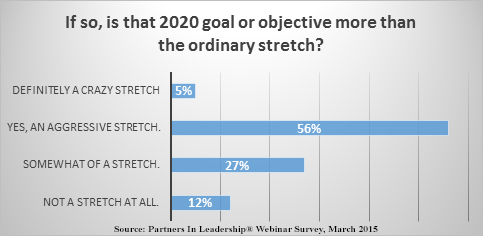
Recently, we surveyed a group of more than 1,000 companies and found that just over half have a stated 2020 objective: to be $100 million, $1 billion, or No. 1 by 2020. We think they will be joined by the other half within the next 12 months. There’s something about the year 2020 that presents a rallying point for organizational aspirations. In a recent lunch discussion with one senior leader, we asked about his 2020 vision. He responded enthusiastically with a number that was cleverly designed to fit with the 2020 theme. We then asked him, “Is that just an idea or do people feel accountable for achieving that?” He paused for a moment and said, “It’s probably seen as an idea, but I need people to feel accountable for achieving it—we need to hit this number!”
Does your company have a 2020 goal, a clear vision for what you’d like to achieve over the next five years? If so, is it just an idea or do people feel accountable for making it happen? Our survey group was equally divided as to how confident they were in achieving their 2020 goals, with half saying that it was more of an aspirational vision. Here’s how they felt about their 2020 objective:

The overall sentiment is clear: 61 percent feel the objective is an aggressive stretch.
So whether your organization is nearsighted or you’re looking beyond the next year or two, let’s explore the value of setting a clear “2020 Vision”—one that people feel accountable to achieve—rather than leaving team members and stakeholders squinting to see what lies ahead. The overall success of an organization is most secure when leaders take a strategic look down the road and can help the organization see that path clearly.
A Simple Vision Correction Procedure
Setting a “2020 Vision” doesn’t have to be difficult. Our prescription: Clearly define your company’s future key results, what we call R2 (R1 being the results you’re producing today) and take the right steps to achieve organization-wide buy-in and alignment around those key results, a process we discuss this extensively in our book, Change the Culture, Change the Game.
When organizational leaders clearly define key results year in and year out, combined with setting milestone goals three to five years ahead (their R2), all levels of the organization achieve greater drive and focus, significantly increasing the likelihood of achieving those goals or key results.
Aligning “all levels” is the key—you really do need to get your entire organization on board, from top leaders to front-line workers. You’ll need a company culture that believes in the R2 key results you’ve outlined, belief being critical to the momentum your R2 requires. As your culture shifts from delivering on annual goals to one also aiming for your R2, the outcome can be astonishing. You’ll begin to experience a workforce that not only ties their job role and tasks to the results for that year but takes ownership for today’s actions that deliver tomorrow’s aims, as well.
Billion Dollar Thinking
Take this inspiring example of a well-known international nonprofit that demonstrated “2020 Vision.”
Children’s Miracle Network Hospitals (CMN Hospitals), an organization whose hospital network is responsible for seeing 16,000 children in emergency rooms daily and performing surgery for 97 children every hour, faced an issue in 2011—its fundraising plateaued at $230 million to $250 million per year and costs to raise money were increasing. In order to sustain their efforts of helping children and to expand services for the growing population of children in need of care, something had to change.
The CEO of CMN Hospitals, John Lauck, decided that a drastic shift in their organizational culture was vitally necessary in order to overcome the challenges of fundraising and increasing costs. Lauck set in motion plans to transform the culture by focusing on using accountability across the entire organization. He wanted everyone to be accountable for the key results of the organization—meaning everybody took ownership in their roles and trusted that the goals of the organization were achievable. He believed that through creating a culture of accountability with an emphasis on delivering results, annual goals not only would be met, but that a landmark goal (R2) could be achieved if, and only if, everyone had bought in.
During a meeting with our team in 2011, Lauck introduced a strategic imperative of quadrupling their fundraising efforts to $1 billion per year by the year 2022 (while not an exact 2020 goal, the example beautifully illustrates the principle). Lauck coined this strategy “Billion Dollar Thinking,” and it became one of the backbone values of the entire organization. Shortly after implementing the cultural transformation with “Billion Dollar Thinking” front of mind, CMN Hospitals’ fundraising increased 13 percent and the cost per dollar raised was reduced 13 percent. In 2012 these results were far surpassed when they saw their fundraising increase by an additional 16 percent. Increases like these were unheard of in an industry where the average was a 0 to 3 percent increase over the same period.
In an effort to create an experience that would increase momentum toward their R2, Lauck told the organization that if they hit $300 million in 2012 he would shave his head (the goal was $280 million). When the organization exceeded $300 million in fundraising, he did just that—in front of his employees at a company celebration. After his head was shaved, he told the company (memorialized with this YouTube video), “If this is what $300 million looks like, I’ll wear it every day!” This experience shaped the “Billion Dollar Thinking” belief and inspired the entire organization to feel that their R2 of $1 billion per year in fundraising was in reach—reinforcing the cultural transformation, improving engagement, and increasing ownership at all levels of the organization.
Now, three years later, CMN Hospitals indicates that it is on track to hit $1 billion per year in fundraising by 2022, with a potential to hit the goal in 2021—a year ahead of schedule. That’s the power of getting strategic about making your company’s future goals clear and visible. That’s the power of having “2020 Vision.”
Your 2020 Prescription
Here are a few steps to follow in setting your own 2020 R2—some easier than others:
- Get clear on the annual key results you currently have in place and whether you’re hitting these goals. Again, what you’re achieving today is your R1.
- Develop a pretty good idea of where you want your company to be in five years.
- Develop a meaningful, measurable, and memorable set of future key results (R2) with these ideas in mind and make sure that these 2020 goals are aggressive, but obtainable—your R2 must be achievable to inspire action and motivation. There’s nothing like an overly stretched and unobtainable goal to impede morale and cause failure faster.
- Once you’ve defined your R2 key results, assess your company culture. Is your current culture (C1) one that can deliver your R2 key results? In nearly three decades of experience working with organizations like yours, we’ve never found a C1 culture that can deliver R2 key results. Instead, you’ll need a revised culture, a C2 culture, to ultimately deliver your R2 key results.
Back to our example above, John Lauck noted that his previous culture, C1, was incapable of sustaining the challenges that CMN Hospitals was facing and of delivering R2. He decided that a large-scale transformation from C1 to C2 was necessary, ultimately resulting in a culture that felt accountable and demonstrated high levels of ownership for achieving R2. Now CMN Hospitals is on the right path.
Not every culture shift is large scale, but every culture shift is transformational. So ask yourself again, can your C1 culture deliver the R2 key results you have in mind?
Perfect Vision Today
We’re already a day closer to 2020 than yesterday. Do you like what you’re seeing? If you’re squinting at a future of unclear goals, foggy results, and a C1 culture, don’t waste another moment and get “2020 Vision” today.
Click below to download an infographic on this topic.
Roger Connors and Tom Smith are the four-time New York Times bestselling authors of an extensive body of knowledge on workplace accountability and are considered experts on the subject. Their company, Partners In Leadership, is a premier provider of accountability training and culture change services and has enabled thousands of companies and millions of people to achieve dramatic results. Learn more at www.partnersinleadership.com.




